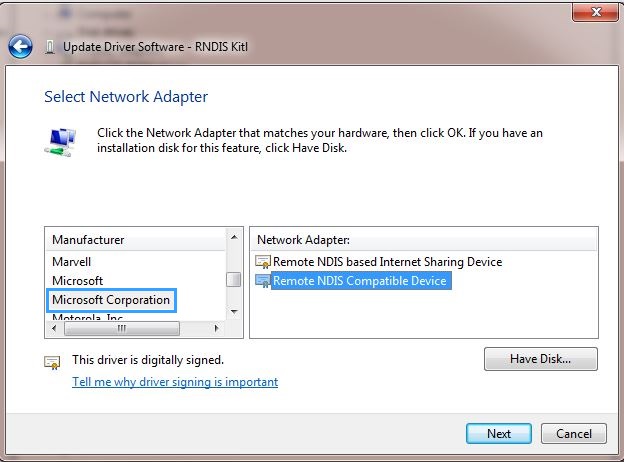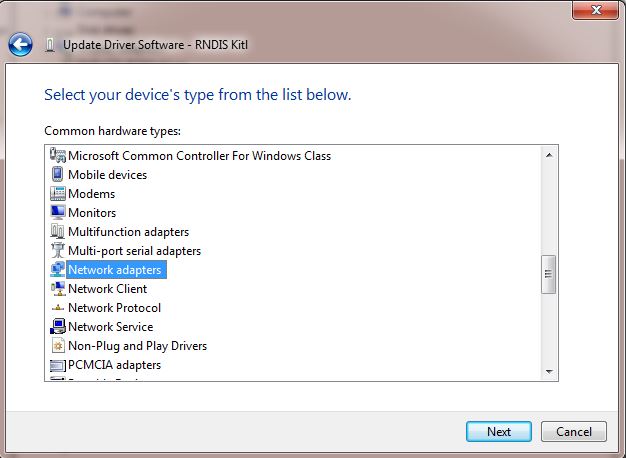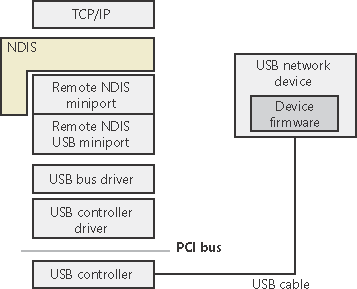Ndis.sys is a Windows system file related to Network Driver Interface Specification. Being essential part of the Windows operating system, ndis.sys is digitally signed by Microsoft and is located in the C: Windows System32 drivers folder. Ideally, this file should not affect your PC’s performance or cause any issues. An NDIS driver is a type of device driver on your computer that manages your machine's networking adapters. This driver allows your operating system to recognize the networking devices installed in your computer, which in turn allows you to go onto wired or wireless Internet connections. On Windows 7/8/10, it is detected and windows installs an Acer RNDIS driver, which does not work and causes the Network and Sharing center to lock up. In Windows 7/8, I was able to select the 'Microsoft Corporation' 'Remote NDIS Compatible Device' driver (via Device Manager, right-click and select 'Update Driver.' ) and get it working.
Have you encountered the BUGCODE_NDIS_DRIVER BSOD error during the installation of Windows 10? You are not alone. Many Windows 10 users are getting the same blue screen BUGCODE_NDIS_DRIVER error as well. While some were able to resolve the error by simply restarting their computer, others had to try various solutions, which we have listed below. But before we share them with you, let us find out what this error is all about.
- Industrial Mesh, Intelligent Digital Security, Intelligent Platform & Services, Mobile Computing, Medical & Healthcare Infor, Network & Communication, Smart Manufacturing & Open Robots & Machines.
- Remote ndis rndis eliminates the need for hardware vendors to write an ndis miniport device driver for a network device attached to the usb bus. Remote ndis rndis is remote ndis device. Remote ndis based internet sharing device 5. Remote ndis based internet sharing device 2 driver for windows 7 32 bit, windows 7 64 bit, windows 10, 8, xp.
What Is the BUGCODE_NDIS_DRIVER Error?
The BUGCODE_NDIS_DRIVER error usually appears while updating or installing Windows 10. That said, it is safe to assume that it could be associated with a faulty driver that has been loaded for a certain network device in the process of updating. With a problematic driver running, your system may command an abrupt shutdown of your computer. This way, further data loss and damage are prevented.
Other Causes of the BUGCODE_NDIS_DRIVER Blue Screen Error
Apart from faulty drivers, there are many potential causes of the BUGCODE_NDIS_DRIVER BSOD error. These include the following:
- Incorrect configuration of device drivers
- Corrupted device drivers
- Windows registry corruption caused by installing or uninstalling an app
- Malware infection
- Driver incompatibility
- Corrupted RAM
6 Feasible Solutions to Try to Fix the BUGCODE_NDIS_DRIVER Error
So, how do you fix the BUGCODE_NDIS_DRIVER BSOD error on Windows 10? Here are six solutions to try:
Solution #1: Be Sure That Windows 10 Is Up to Date.
Software and hardware issues are among the most common causes of BSOD errors like the BUGCODE_NDIS_DRIVER BSOD error. To avoid or fix these issues, experts recommend updating Windows 10 by using the Windows Update utility. Download the latest patches as they often come with fixes to the reported issues with the previous Windows versions.
Solution #2: Ensure Your Drivers Are Updated.
Oftentimes, your drivers cause BSOD errors to appear. This is because they might no longer be compatible with your newly updated Windows 10 OS. To ensure your computer is free of errors, make it a habit to update your drivers regularly.
Updating your drivers is easy. You can do it by simply visiting the website of the hardware manufacturer and downloading the latest drivers for your device. It’s that easy! However, it is worth noting that not all driver versions support your computer. To be safe, we suggest that you use Outbyte Driver Updater.
This tool scans your computer for any missing, corrupted, or outdated drivers and lets you quickly update them to the most recent and stable versions. It also prevents any driver-related errors and helps your computer run faster and more efficiently.
Solution #3: Disable Your WiFi Adapter Software.
According to some users, there seems to be a problem with certain WiFi adapter programs for Windows 10. They are claiming that these programs are causing Windows BSOD errors to occur, including the BUGCODE_NDIS_DRIVER BSOD error.
As a possible workaround, we suggest that you unplug your WiFi adapter before starting your computer. Better yet, close or disable your WiFi adapter program and run it as soon as your computer starts.
Solution #4: Revert to the Previous Driver Version.
Obviously, the BUGCODE_NDIS_DRIVER BSOD error is mostly triggered by problematic drivers. Download 824sh driver. So, to potentially solve the error, try reverting back to the previous version of your driver.
To install the previous version of a driver, follow these steps:
Remote Ndis Driver

- Press the Windows and X keys to launch the Power User menu.
- Choose Device Manager.
- As soon as the Device Manager opens, find your WiFi adapter and double-click on it.
- Go to the Driver tab.
- Hit the Roll Back Driver button.
- Follow the onscreen prompts to revert to the previous version of your driver.
- Restart your computer to apply the changes.
In the event that you are unable to roll back to the previous driver version, run your computer in Safe Mode. Here’s how:
- Press and hold the Shift key and Power button.
- Select Troubleshoot.
- Click Advanced Options.
- Choose Startup Settings.
- Hit Restart.
- Once your computer restarts successfully, you will be greeted by a number of options. Choose Safe Mode with Networking by simply pressing the F5 key.
The moment you enter Safe Mode, revert to the previous version of your WiFi adapter driver. You may also uninstall the faulty driver and download an older version of it.
The DriverUpdate™ Utility is compatible with your Windows® operating system. Free Scan for Windows® 10, 8, 7, Vista & XP Operating Systems. Charges apply for license with premium features. See registration process for full details. Acer laptop and netbook drivers. Install drivers automatically. Windows XP, 7, 8, 8.1, 10 (x64, x86) Category: Laptops. Subcategory: Acer laptops. DriverPack Online will find and install the drivers you need automatically. Download DriverPack Online for free. All app versions DriverPack removal Hardware Manufacturers. Updates are recommended for all Windows 10, 8, Windows 7, XP and Vista users. Download and install Acer Drivers. If you are having problems with an Acer PC or another Acer device, the problem could be with your Acer Drivers. This often happens when users upgrade to a new Operating System and fail to update their Drivers so the Acer Drivers may. Acer 1zy9bbr0tn5 drivers download for windows 10 8.1 7 vista xp 32-bit. Download Acer modem drivers or install DriverPack Solution software for driver scan and update. Windows XP, 7, 8, 8.1, 10 (x64, x86) Category: modems. Subcategory: Acer modems. DriverPack Online will find and install the drivers you need automatically. Download DriverPack Online for free. All app versions.
Solution #5: Perform a Clean Boot.


Performing a Clean Boot before updating your Windows 10 OS version can resolve the BUGCODE_NDIS_DRIVER BSOD error. Follow these steps to perform a Clean Boot:

Remote Ndis Usb Driver Download
- Press the Windows and R keys.
- Into the text field, input msconfig.
- Hit Enter.
- The Windows Configuration window should now appear. Choose Selective startup and untick the Load startup items option.
- Navigate to the Services tab.
- Check the Hide All Microsoft Services option.
- Click the Disable All button.
- Hit Apply and then If you are prompted to restart your computer, just ignore it.
- Now, open the Task Manager by pressing the CTRL, Shift, and Esc keys.
- As soon as the Task Manager opens, go to the Startup tab.
- Right-click on every entry on the list and click Disable.
- Once you are done, close the Task Manager.
- Reboot your computer and wait for the changes to take effect.
Solution #6: Remove System Junk and Unnecessary Files.
More often than not, viruses and malware disguise themselves as system junk. By running a quick system scan, you can identify these harmful files and delete them as needed.
One of the easiest ways to remove system junk is by installing a third-party PC Repair tool. With a reliable PC repair tool, you can scan your system automatically and locate junk files that are causing your system to crash.
Conclusion
Remote Ndis Download
BSOD errors, like the BUGCODE_NDIS_DRIVER error, aren’t always as fatal as you think. While most of them occur because of an outdated driver, others are triggered by system junk. But regardless of what’s causing these errors to appear, it is great to know that there are many feasible solutions you can try.
Then again, if you are not confident about your troubleshooting skills, we strongly suggest that you seek the help of experts. Have a professional technician check your computer and ask for the best possible recommendations to fix your problem.
Which of these solutions have you tried? How was your experience? Let us know in the comments!
See more information about Outbyte and uninstall instructions. Please review EULA and Privacy Policy.